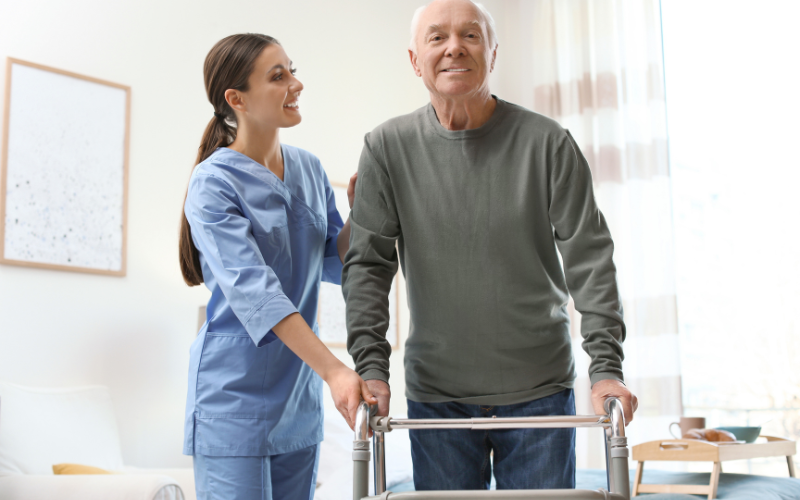
If you or a loved one is aging in place, some adjustments to the home might be necessary. The first consideration should be the stairs, as they can pose a hazard regardless of their location in the house. Whether it’s stairs to the basement, a second-floor bedroom, or a walkway from the deck to the yard, the risk remains.
Stair-related injuries are alarmingly common, with approximately 3,000 incidents occurring daily in the U.S. This translates to one injury every 30 seconds. Notably, the risk of these injuries increases with age, as highlighted by a 2017 study on emergency room visits.
Stairs pose a significant risk to people of all ages. However, as we age, navigating stairs becomes more challenging due to changes in coordination, vision, and strength. Certain conditions can further increase the risk of injury or falls in older adults. For instance, those with osteoporosis are more likely to break a bone, while individuals on anticoagulants face the danger of intracranial bleeding if they hit their head.
Given that stairs are common in most American homes, it is crucial to mitigate the risks they pose, especially to older adults. Falls can lead to severe injuries, making it imperative to take preventive measures. In this article, we will discuss various strategies to prevent falls on stairs in your home, helping to safeguard both your loved ones and your property from injury and damage.
Lowering the Risk Falls Due to Stairs
To reduce the risk of injuries from falling down the stairs, consider modifying both the design and environment of your home. Here are some steps to enhance the safety of your stairs:
1. Add Traction to the Stairs
Most injuries from falling down the stairs are due to slipping rather than tripping. Therefore, it is crucial to ensure stairs are not slippery. Whether the steps are made of wood or tile, they can pose a danger, especially to older adults. Adding materials to increase friction and traction is essential.
Rubber or abrasive stair treads, anti-slip tape strips, or skid-resistant floor treatments are effective options. Alternatively, low-pile carpeting can be installed, but it should be tightly fitted by a professional to prevent tripping. Additionally, even with non-slip flooring, it’s vital for seniors to wear shoes with rigid rubber soles on stairs to further reduce the risk of slipping.
2. Add Lights for Better Visibility
Many of the falls down the stairs for people in all age groups are due to poor lighting. To prevent such accidents, it’s crucial to install bright LED bulbs to ensure the stairs are well-lit, particularly at the top and bottom where most falls occur. Additionally, having a light switch at both ends of the stairs is advisable. If installing these switches isn’t feasible, consider purchasing wall-mounted, wireless motion-sensor night-lights at foot and ankle levels to enhance visibility and reduce the risk of falls.
3. Increase Visual Cues
As people age, they may struggle to distinguish individual steps, particularly when going down the stairs. This difficulty arises due to reduced depth perception and challenges in adapting to varying light conditions. The problem is worse if the stairs are very light or dark in color. A simple solution is to apply reflective tape or colored paint to each step, providing clear markings. Additionally, painting the vertical portions of the steps white or in a contrasting color can help separate the risers from the treads, making it easier to identify where to step.
4. The Height and Depth of the Steps Should Be Uniform
Ensure that the horizontal and vertical surfaces of your stairs are uniform in width and height to prevent tripping. In many older homes, the top step is often larger and wider than the others, which can increase the risk of falls. To enhance stair safety, consider hiring a carpenter to add nosing to the landing. This modification will significantly improve the safety of the stairs.
5. Eliminate the Illusion of the Bottom Step
In some older homes, the bottom steps blend into the landing instead of standing out as part of the staircase. This can be hazardous, as someone might mistakenly believe they are stepping onto a flat surface. Known as the “bottom-of-the-flight illusion,” it is necessary to clearly differentiate the bottom step from the landing. One effective solution is to mark it with rubber tread or anti-slip tape.
6. Upgrade the Handrail
Handrails are crucial in homes, especially those with elderly residents, as they assist with balance and prevent falls. While often seen as decorative in many households, they should prioritize function over form. Bulky and ornate handrails can be difficult to grasp, so it’s best to choose rounded rails that your hand can fully encircle.
For added safety, consider installing rails on both sides of the stairs, which can provide better support for those with balance issues and offer comfort regardless of which side is used. Ensure the handrails extend the entire length of the staircase, are installed 30 to 36 inches from the floor, and are securely anchored to the wall studs to support significant weight.
7. Remove Any Clutter
Stairways should always be kept clear of clutter to avoid tripping. There should not be any throw rugs on the landing or any items on the stairs such as items that need to be taken upstairs.
8. Get a Stair Lift
If it is difficult for you or a loved one to navigate stairs in the home, you should consider getting a motorized lift installed. The cost can be anywhere from $2,000 to $10,000, but some insurance companies will reimburse you for part of the cost. Installing a motorized stair lift can be done in one day, but the stairway does have to be wide enough to accommodate a chair while others can still use the staircase with the chair already in place. If the home is being sold, the lift can be removed without major damage to the actual staircase.
Professional Home Care Services

The stairs can be one of the most dangerous features of the home for seniors, especially those with mobility issues. If you or your senior loved ones have difficulty with the stairs, taking the steps outlined above can make using the stairs easier and safer, reducing the risk of falls and serious injuries. Having someone in the home with them to provide assistance can also ensure that they move around the home safely.
Assisting Hands Home Care provides senior home care services that include personal care and assistance to help seniors live safely at home. Our licensed caregivers can help your senior loved ones with activities of daily living (ADLs) such as personal hygiene, eating, and transferring, including safely getting up and down the stairs. The quality, compassionate care we provide will help give you and your loved ones some peace of mind.
To learn more about our in-home care services in Burleson, Cleburne, Mansfield, Midlothian, Waxahachie, TX, and the surrounding areas, give us a call at (817) 592-8843.







